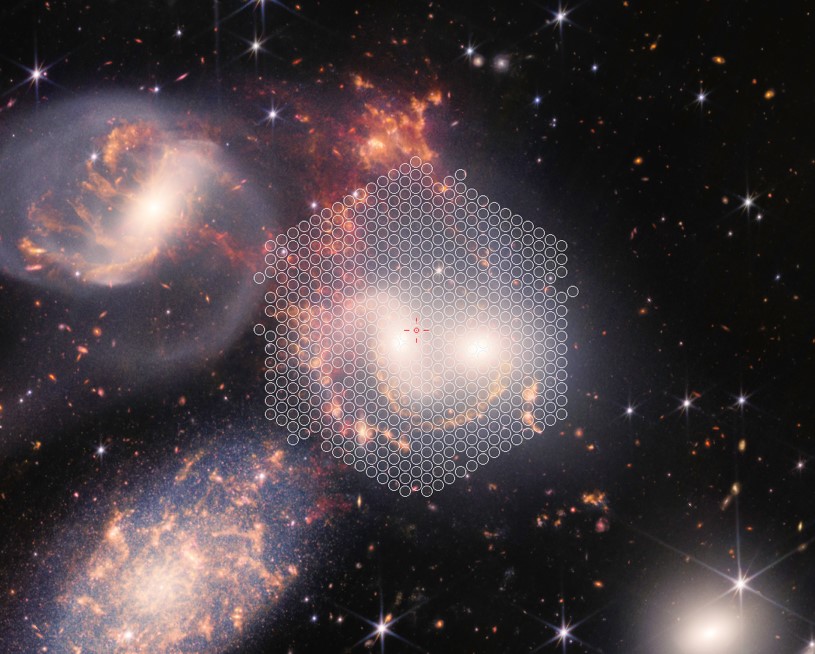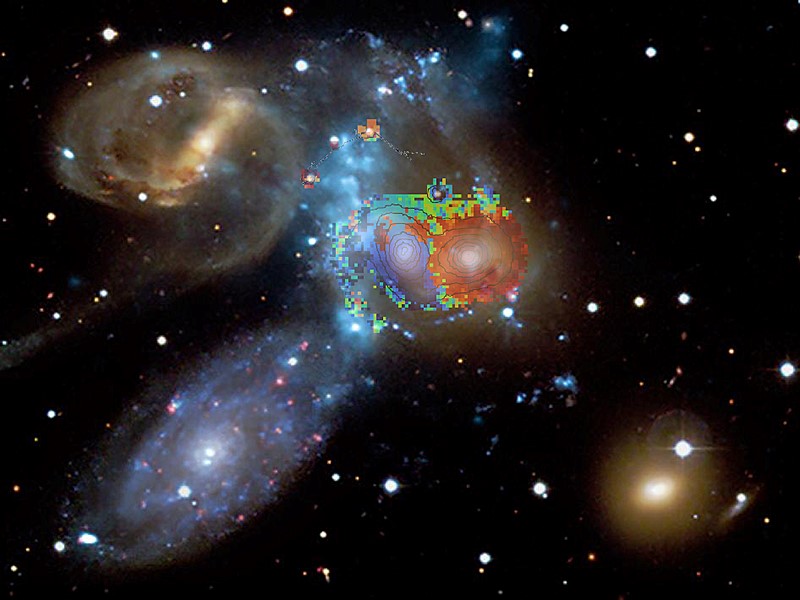
First light for the next-generation spectrograph WEAVE
|
|
WEAVE, a new spectrograph on the William Herschel Telescope (Canary Islands, Spain), has successfully carried out first-light observations of a group of five galaxies called Stephan's Quintet, thus demonstrating its unprecedented capabilities and providing the astronomical community with the promise of many new discoveries. In France, WEAVE was supported by the CNRS, the Paris Observatory-PSL and the Côte d'Azur Observatory.
The powerful new WEAVE spectrograph mounted on the William Herschel telescope at the Roque de los Muchachos Observatory provides astronomers with observations almost a hundred times faster than with previous instruments, as it demonstrated when it captured its first-light images of Stephan's Quintet, a group of five galaxies of which some are undergoing collision.
The scientists of the Isaac Newton Group of Telescopes (ING)1 focused specifically on two of them, NGC 7318a and NGC 7318b. The spectra reveal the presence of gas well outside the galactic discs: hydrogen gas clouds are being pushed out of their orbits by the intrusion at very high speeds, approaching 3 million km/h, of the galaxy NGC 7318b, which is moving directly towards us through the centre of Stephan's Quintet (see images).
The observations were made with one of the three WEAVE fibre systems, in which 547 very closely packed optical fibres transmit light from a hexagonal area of the sky to the spectrograph, where it is analysed and recorded. WEAVE's first-light observations show not only that it works, but also that it produces high-quality data that hold out the promise of major discoveries in the years to come.
In France, the construction of WEAVE was funded by the CNRS, the Paris Observatory-PSL, and the Île-de-France2 and Bourgogne-Franche-Comté regions. It also benefited from the expertise of the ‘Galaxies, Etoiles, Physique, Instrumentation' (Observatoire de Paris-PSL/CNRS) and Lagrange (CNRS/Observatoire de la Côte d'Azur/Université Côte d'Azur) laboratories, with the support of the Observatoire des Sciences de l'Univers ‘Terre Homme Environnement Temps Astronomie' (CNRS/Université Bourgogne Franche-Comté) and the Institut ‘Univers, Temps-fréquence, Interfaces, Nanostructures, Atmosphère et Environnement, Molécules' (CNRS/Université Bourgogne Franche-Comté). These French laboratories will participate alongside others3 in future observation programmes.
For more information, see our previous press release and ING’s press release.

© NASA, ESA, CSA, STScI (background image); Aladin (fibre overlay)

© NASA, ESA, CSA, STScI (background image); Aladin (fibre overlay)

© WEAVE
- 1The ING comprises two telescopes located at the Roque de los Muchachos Observatory. In 2016, the ING partner countries (the UK, Spain and the Netherlands), joined by France and Italy, signed an agreement to design and build WEAVE, with each country contributing to the major components, and ING providing auxiliary systems and overall project management.
- 2The WEAVE project was funded under the Major Area of Interest ‘Astrophysics and conditions for the emergence of life' 2012-2016 of the Île-de-France region (France).
- 3The Laboratoire d'Astrophysique de Marseille (CNRS/Aix-Marseille Université/CNES), the Laboratoire d'Astrophysique de Bordeaux (CNRS/Université de Bordeaux), the Institut de Planétologie et d'Astrophysique de Grenoble (CNRS/Université Grenoble Alpes) and the Observatoire Astronomique de Strasbourg (CNRS/Université de Strasbourg).


